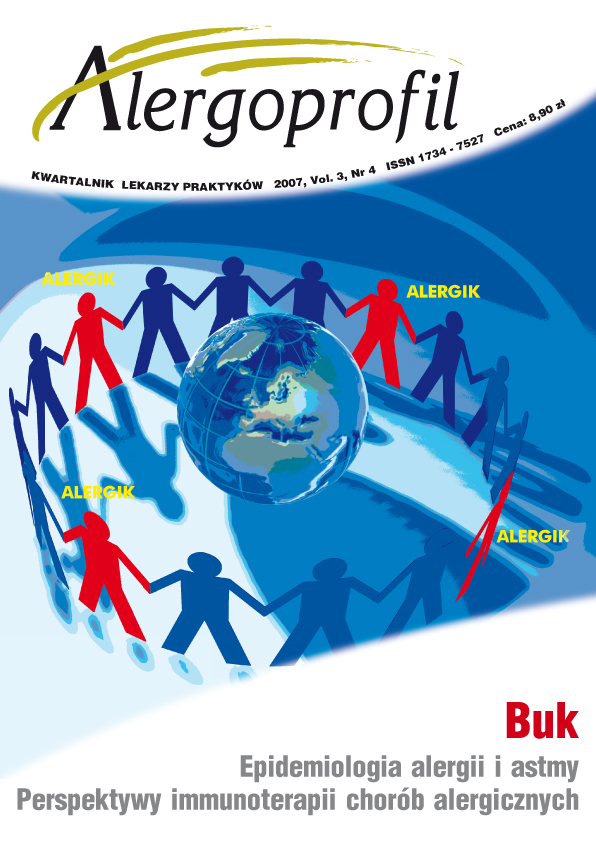Meszki
##plugins.themes.bootstrap3.article.main##
Abstrakt
Ukąszenia owadów mogą być przyczyną reakcji toksycznych i alergicznych na białka znajdujące się w ślinie. Reakcje nadwrażliwości mogą mieć postać miejscową lub systemową. Niekiedy obserwuje się cięższe reakcje miejscowe, obejmujące kilkucentymetrowy obrzęk i reakcje pęcherzowe z towarzyszącą gorączką, limfoadenopatią i ogólnym złym samopoczuciem. Autorzy omawiają medyczne, weterynaryjne i alergologiczne zagadnienia związane z meszkami w Polsce i Europie.
Pobrania
##plugins.themes.bootstrap3.article.details##
Copyright: © Medical Education sp. z o.o. This is an Open Access article distributed under the terms of the Attribution-NonCommercial 4.0 International (CC BY-NC 4.0). License (https://creativecommons.org/licenses/by-nc/4.0/), allowing third parties to copy and redistribute the material in any medium or format and to remix, transform, and build upon the material, provided the original work is properly cited and states its license.
Address reprint requests to: Medical Education, Marcin Kuźma (marcin.kuzma@mededu.pl)
Bibliografia
2. Smorawska-Sabanty E., Kowalski M.L.: Immunoterapia innych postaci alergii IgE-zależnej. W: Kowalski M.L. (red.): Immunoterapia alergenowa. Mediton, Łódź 2003.
3. Rapiejko P.: Alergeny i preparaty alergenowe. W: Kowalski M.L. (red.): Immunoterapia alergenowa. Mediton, Łódź 2003.
4. Rapiejko P., Lipiec A.: Alergeny jadu owadów błonkoskrzydłych. Alergoprofil 2006; 2(3): 17-22.
5. Samolinski B., Zawisza E.: Epidemiology of mites allergy of upper respiratory tract and mites occurrence in homes in Warsaw. Pneumonol Alergol Pol. 1993; 61(3-4):148-51.
6. Samoliński B., Zawisza E., Rapiejko P.: Clinical picture of mite allergy. Int. Rev. Allergol. Clin. Immunol., 1995; 1(3) : 24-29.
7. Boczek J.: Roztocze. W: Majkowska-Wojciechowska B.: Alergia na roztocze. Mediton, Łódź 2005.
8. Rapiejko P., Jurkiewicz D., Ligęziński D.: Objawy zapalne górnych dróg oddechowych wywołane przez brudnicę mniszkę. Nowa Med., 1997; 4(2): 48-50.
9. Rapiejko P., Lipiec A.: Komary – nie tylko alergia. Alergoprofil 2006; 2(2): 21-25.
10. Wirtz H.P.: Bioamines and proteins in the saliva and salivary glands of Palaearctic blackflies (Diptera: Simuliidae). Trop. Med. Parasitol. 1990; 41(1):59-64.
11. Tabachnick W.J.: Pharmacological Factors in the Saliva of Blood-Feeding Insects: Implications for Vesicular Stomatitis Epidemiology. Annals of the New York Academy of Sciences 2000; 916:444-452.
12. Abebe M, Cupp M.S., Ramberg F.B. et al.: Anticoagulant acti vity in salivary gland extracts of black flies (Diptera: Simuliidae). J. Med. Entomol. 1994; 31(6):908-11.
13. Orange J.S., Song L.A., Twarog F.J. et al.: A patient with severe black fly (Simuliidae) hypersensitivity referred for evaluation of suspected immunodeficiency. Ann. Allergy Asthma Immunol. 2004; 92(2):276-80.
14. Cross M.L., Cupp M.S., Cupp E.W. et al.: Antibody responses of BALB/c mice to salivary antigens of hematophagous black flies (Diptera: Simuliidae). J. Med. Entomol. 1993; 30(4):725-34.
15. Lachmajer J.: Przegląd krajowych badań w zakresie arachnoentomologii lekarskiej. W: Żółtowski Z.: Arachno-entomologia lekarska. PZWL, Warszawa 1976.
16. Shevchenko A.K., Salo Z.T.: Blood-sucking black flies (Diptera simuliidae) of the Ukrainian Polesye (w j. rosyjskim). Med Parazitol (Mosk). 1969; 38(1):16-21.
17. Mukanov S.M.: Attacks of black flies (Diptera, Simuliidae) on man in the Udmurt ASSR (w j. rosyjskim). Med Parazitol (Mosk).1985; (3):87-9.
18. Eckert J., Gloor H., Karbe E. et al.: Cases of death caused by black flies (Simuliidae, Diptera) in cattle in Switzerland (w j. niemieckim). Schweiz. Arch. Tierheilkd. 1969; 111(8):447-55.
19. Lachmajer J., Skierska B.: Gromada: Owady, rząd: dwuskrzydłe – (muchówki). W: Żółtowski Z.: Arachno-entomologia lekarska. PZWL, Warszawa 1976.
20. Niesiołowski S., Bokłak E.: Meszki (Simuliidae, Diptera). Fauna Słodkowodna Polski, zesz.11A. Polskie Towarzystwo Hydrobiologiczne, Wydawnictwo UŁ, Łódź 2001.
21. Crosskey R.W.: The natural history of blackflies. Chichester 1990.
22. Jariyapan N, Takaoka H, Choochote W. et al.: Morphology and electrophoretic protein profiles of female salivary glands in four Oriental black fly species (Diptera: Simuliidae). J. Vector Ecol. 2006; 31(2):406-11.
23. Zivkovis V., Burany B.: An outbreak of Boophthora erythrocephala in Yugoslavia in 1970. Acta Vet. Beogr. 1972, 22,3:133-142.
24. Zwolski W.: Studia nad składem gatunkowym, ekologią i rozmieszczeniem meszek (Simuliidae, Diptera) Polski. Rozpr. Nauk., AR Lublin, 1974.
25. Farkas J.: Occurrence of simuliosis in humans in Bratislava. Skin manifestations following black-fly sting of the genus Simuliidae. Dermatol Monatsschr. 1983; 169(5):317-21.
26. Wach B.: Pathological symptoms and skin changes in humans caused by the bites of insects from the Simuliidae family (w j. polskim). Przegl. Dermatol. 1985; 72(3):263-7.
27. Dolovich J., Kwee Y.N., Grenbaum J.: Reactions to mosquito and blackfly bites. Ca Med. Assoc. J.,1982; 126(10: 1147).
28. Deryło A.: Classis: Insecta Linnaeus, 1758 – Gromada Owady. W: Dyrełko A. (red): Parazytologia i akaroentomologia medyczna. PWN, Warszwa 2002.
29. Kipp W., Bamhuhiiga J., Rubaale T. et al.: Adverse reactions to ivermectin treatment in Simulium neavei-transmitted onchocerciasis. Am. J. Trop. Med. Hyg. 2003; 69(6):621-3.
30. Myburgh E., Nevill E.M.: Review of blackfly (Diptera: Simuliidae) control in South Africa. Onderstepoort J. Vet. Res. 2003; 70(4):307-16.
31. Jariyapan N., Takaoka H., Choochote W. et al.: Morphology and electrophoretic protein profiles of female salivary glands in four Oriental black fly species (Diptera: Simuliidae). J. Vector Ecol. 2006; 31(2):406-11.
32. Kruszewski J.: Alergia, anty-IgE, pasożyty. Alergia, 2001, 4 (11): 12-15.

